Bandoneon terminology is an essential part of understanding the instrument, especially since the words and expressions used in the bandoneon’s context are deeply rooted in Argentina and the terms used for the bandoneon are in Spanish, despite the bandoneon having originated in Germany.
Due to the massive use of bandoneon in tango, many terms in bandoneon terminology are derived from Spanish, often using colloquial language. For instance, words like peine (literally “comb”)—a key part of bandoneon terminology—refer to a specific component, the reed support plate. This specialized bandoneon terminology can be confusing, especially for beginners.
In this page, you’ll find translations and definitions for the most common terms related to the bandoneon, whether they describe playing techniques or the instrument’s anatomy, or instrument’s history and so on.
This bandoneon terminology resource is organized alphabetically, and each term is categorized by context, such as (tech.) for playing technique. (instr.) for instrument anatomy and so on.
If you’re new to the bandoneon or looking to deepen your understanding, this comprehensive guide to bandoneon terminology will help clarify the language of the instrument.
(br.) – Brand. It refers to bandoneons brands.
(instr.) – Instrument. It refers to the construction details of the instrument, such as its components or specific design features.
(maint.) – Maintenance. It refers to processes of tuning or the aesthetic and functional maintenance of the bandoneon.
(tax.) – Taxonomy. Refers to the classifications of bandoneons.
(tech.) – Technique. Refers to bandoneon’s playing technique.
AKA – Also Known As.
1/2 nácar (tax.) – AKA medio nácar – Refers to the bandoneon with partial mother-of-pearl (nácar) decorations that in the bandoneon factories was called Jugendstil.
The bandoneon factories changed the style of the Jugendstil models and the medio nácar definition refers to the Jugendstil old style models.
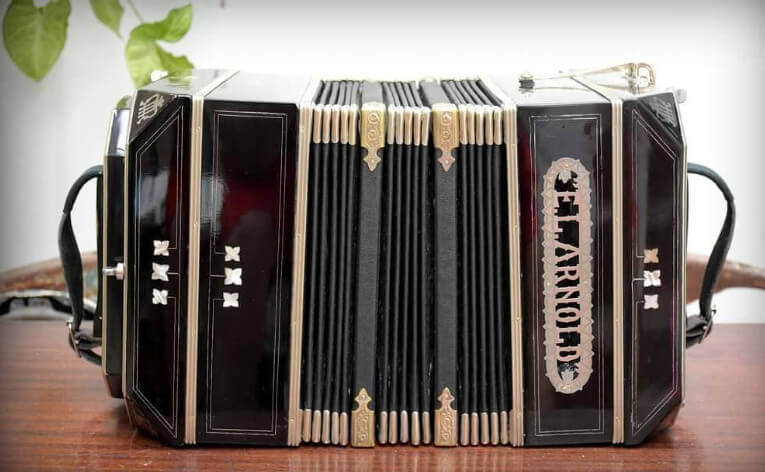
3/4 nácar (tax.) – AKA trés cuartos nácar – Refers to the bandoneon with partial mother-of-pearl (nácar) decorations that in the bandoneon factories was called Jugendstil.
The bandoneon factories changed the style of the Jugendstil models and the 3/4 nácar definition came out in Argentina to distinguish those instruments from the older Jugendstil.
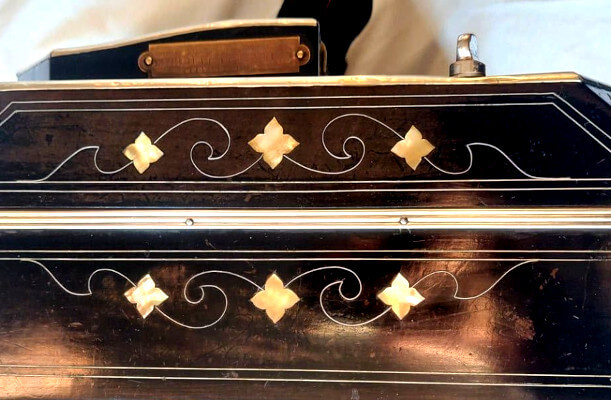
3B (br. – tax.) – AKA BBB, Trés B – Refers to the brand of bandoneons produced for Meinel & Herold in Germany.
In some cases Meinel & Herold produced the 3B bandoneons, in other cases the production was terzerized to other manufacturers.
AA (br. – tax.) – AKA Alfred Arnold, Doble A – Refers to the brand of bandoneons produced in the Alfred Arnold Bandonion und Konzertina Fabrik in Germany.
The Alfred Arnold produced bandoneons under other brands (Premier) as well as bandoneons for other distributors: Campo, Meinel & Herold (3B), Tipico.
Alfred Arnold (br. – tax.) – AKA AA, Doble A – Refers to the brand of bandoneons produced in the Alfred Arnold Bandonion und Konzertina Fabrik in Germany.
The Alfred Arnold produced also the Premier bandoneons as well as bandoneons under other brands for other distributors Campo, Meinel & Herold (3B), Tipico.
Abriendo (tech.) – Literally it means opening. It refers to the movement of pulling, that’s to say opening the bellows.
In the scores it is indicated by the letter A or by the sign V (as the bow up for the violin).
Although it is very common to favor the opening movement of bellows, the correct technique of bandoneon requires the mastery of the closing as well. This is confirmed by the greatest bandoneon players, such as Marcos Madrigal, who in his method for bandoneon writes:
Playing exclusively opening can be a facilitation and a temptation for the less technically gifted, but it involves a great risk: the wrist hardens and you will inevitably lose flexibility and agility in the fingers.
BBB (br. – tax.) – AKA 3B, Trés B – Refers to the brand of bandoneons produced for Meinel & Herold in Germany.
In some cases Meinel & Herold produced the 3B bandoneons, in other cases the production was terzerized to other manufacturers.
Bisonoric (tax.) – Any bandoneon where pressing a button produces two different notes depending on the direction of the bellows (abriendo or cerrando).
The most popular model of unisonoric bandoneon is the 142 Rheinische Tonlage. For a better understanding of the 142 system, an article on the 142 keyboard layout is available.
The bandoneons that produce the same sound by opening and closing the bellows are called unisonoric.
The term bisonoric replaces the previous definition of diatonic, which is incorrect because the bandoneon is a chromatic instrument, that is, it presents all the notes and alterations both in opening and closing.
Burckhardt (br.) – Bandoneon and concertina builder in Saxony, Germany, contemporary of the Arnold dynasty. The production of Paul Burckhardt was limited and artisanal. Very few examples are known.
Cabezal (instr.) – It literally means “headboard” and refers to each of the two wooden structures of the bandoneon that support the keyboard (teclado), the keyboard mechanism (maquina) and the keyboard cover (tapa).
Cerrando (tech.) – Literally it means closing. It refers to the movement of pulling, that’s to say opening the bellows.
In the scores it is indicated by the letter C or by the sign ⎴ (as the bow down for the violin).
The correct technique of bandoneon requires the mastery of the closing as well.
Chromatic (tax.) – In the context of bandoneon is an incorrect yet still used term for unisonoric bandoneon.
Diatonic (tax.) – In the context of bandoneon is an incorrect yet still used term for bisonoric bandoneon.
Doble A (br. – tax.) – Literally “double A”, this name is used to refer to an instrument built in the Alfred Arnold Bandonion und Konzertina Fabrik in Germany.
Fuelle (instr.) – The bellows of the bandoneon. For synecdoche, it is a synonymous with bandoneon itself.
ELA (br. – tax.) – AKA Ernst Louis Arnold – Refers to the brand of bandoneons produced in the Ernst Louis Arnold Bandonion und Konzertina Fabrik in Germany.
The Ernst Louis Arnold produced also the bandoneons under the brands Germania, Cardenal, Concertista, Tango, America, Echo and C.B. Arnold.
Ernst Louis Arnold (br. – tax.) – AKA ELA – Refers to the brand of bandoneons produced in the Ernst Louis Arnold Bandonion und Konzertina Fabrik in Germany.
The Ernst Louis Arnold produced also the bandoneons under the brands Germania, Cardenal, Concertista, Tango, America, Echo and C.B. Arnold.
Fueye (instr.) – The bellows of the bandoneon and a synonymous with bandoneon itself.
It’s exactly the same as fuelle, because in Buenos Aires Spanish the pronunciations of “LL” and “Y” are the same.
Gebrüder Meinel (br. – tax.) – Refers to the brand of bandoneons produced in the Gebrüder Meinel factory in Germany.
Among the various bandoneon factories that distributed in Argentina The Gebrüder Meinel was probably the one with the lowest distribution. However, the quality of these bandoneons was very high.
Lengüeta (instr.) – The reed of a bandoneon, and of any free-reed instrument as well.
Liso (tax.) – The smooth bandoneon, without mother-of-pearl decorations.
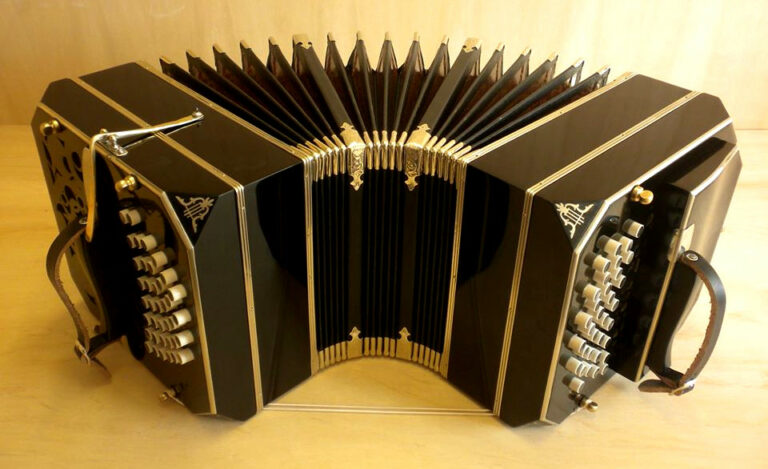
Lustre (maint.) – Process of restoration, maintenance or restoration of the original condition of a bandoneon mueble.
Mano Quieta (tech.) – Means quiet hand and refers to the attitude of the hand while performing a section or a part of a score in a specific region of the bandoneón’s keyboard, and more in general refers to the attitude to play.
The definition of “quiet hand” coincides with that given by a pianist, that’s to say avoiding unnecessary motion in order to achieve control in smooth playing. In the specific case of the bandoneón’s technique it corresponds to the division of the hand’s work into three phases:
During each step the hand stays “quite” avoiding unnecessary movements and “relaxing” in order to perform the specific required task.
Máquina (instr.) AKA mecánica – The assembly of mechanical devices which transmit the pressure of the button (tecla) and allow air to pass through, vibrating the reeds.
Mecánica (instr.) – AKA máquina – The assembly of mechanical devices which transmit the pressure of the button (tecla) and allow air to pass through, vibrating the reeds.
Mueble (instr.) – Indicates everything that makes up the bandoneon if we subtract the bellows, keyboards and maquina (keyboards mechanics).
Nacarado (tax.) – Refers to bandoneons with a complete mother-of-pearl (nácar) decoration.
It is distinguished from the smooth bandoneon without decorations (liso) and from those with partial decorations (1/2 nácar and 3/4 nácar).
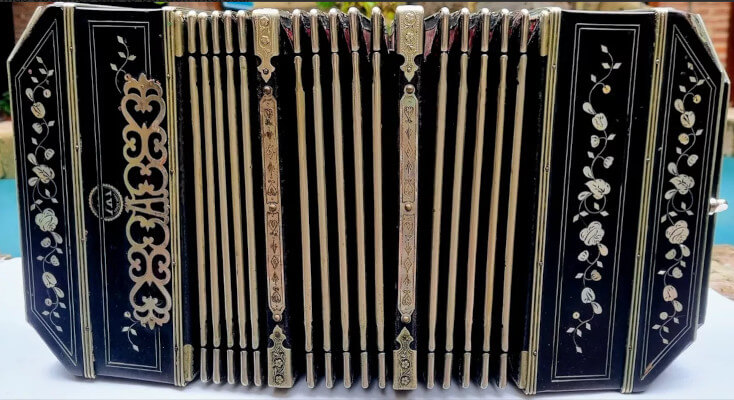
Palanca (instr.) – Any mechanical device with the function of a transmission lever in the bandoneon is called “palanca”. There are two kind of levers in the bandoneon: the first is the “button lever”, which transforms the pressure of the button into the lifting movement of the zapatilla and that permits the air passage through the reed hole. Each button is therefore equipped with this type of lever. In the Bandoneon 142 Rheinische there are a total of 71 levers of this type.
The second type of lever in the bandoneon is the palanca de válvula, which allows you to open the air vent valve through the pressure of the thumb.
Peine (instr.) – literally it means “comb”. It’s the metal plate working as support for the reeds. Generally it’s made of zinc or aluminium.
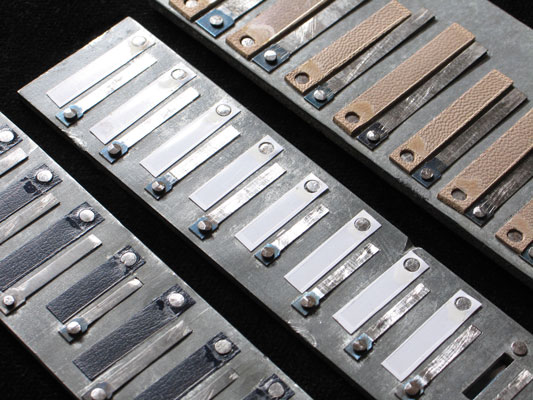
Quiet Hand (tech.) – See mano quieta.
Tapa (instr.) – The wooden structure that sits above each of the two keyboards, featuring holes in the wood corresponding to the buttons.
Tecla (instr.) – the bandoneon’s button. In the old bandoneon models, the buttons were made of galalithe (AKA Erinoid) and decorated with a mother-of-pearl (nácar) circle. Today they are made of plastic, but some manufacturers still use galalithe.
Teclado (instr.) – the bandoneon’s keyboard.
Teclado izquierdo: left keyboard
Teclado derecho: right keyboard.
Unisonoric (tax.) – Any bandoneon where pressing the button produces the same note both opening or closing the bellows.
The most popular model of bisonoro bandoneon is the Peguri. The bandoneons that produce the same sound by opening and closing the bellows are called unisonoric.
The term unisonoric replaces the previous definition of chromatic, which is incorrect because the any bandoneon is a chromatic instrument, that is, it presents all the notes and alterations both in opening and closing.
Válvula (instr.) – Literally it means valve. It’s phe piece of wood that, operated by a lever (palanca) through a cable, allows to pass air in the bandoneon without vibrating the reeds.
The valve hole is usually covered with a sheet metal (chapa de válvula) which prevents the entry of objects that could be harmful to the bandoneon, and which often has the manufacturer’s logo. Bandoneonists who play tango usually remove the chapa because it makes noise when the bellows close quickly.
Zapatilla (instr.) – The name given to the wooden peg, covered at the bottom with soft leather (usually suede) that closes the hole of the reed and that is opened by pressing the button through the mechanical transmission of the palanca (lever).